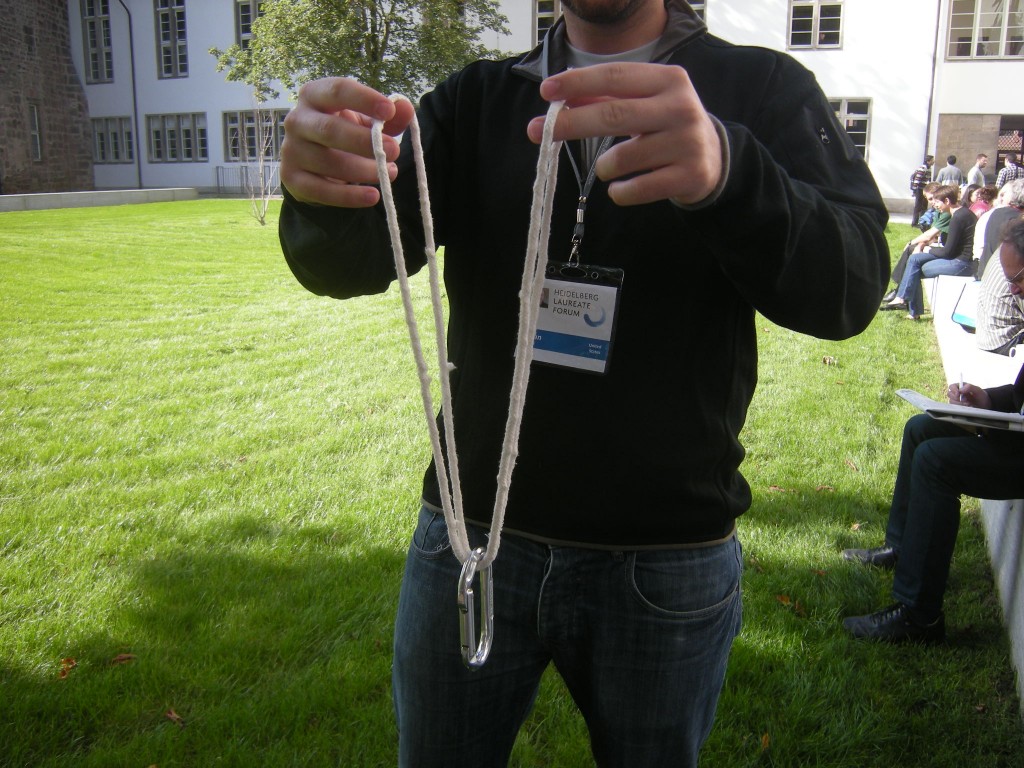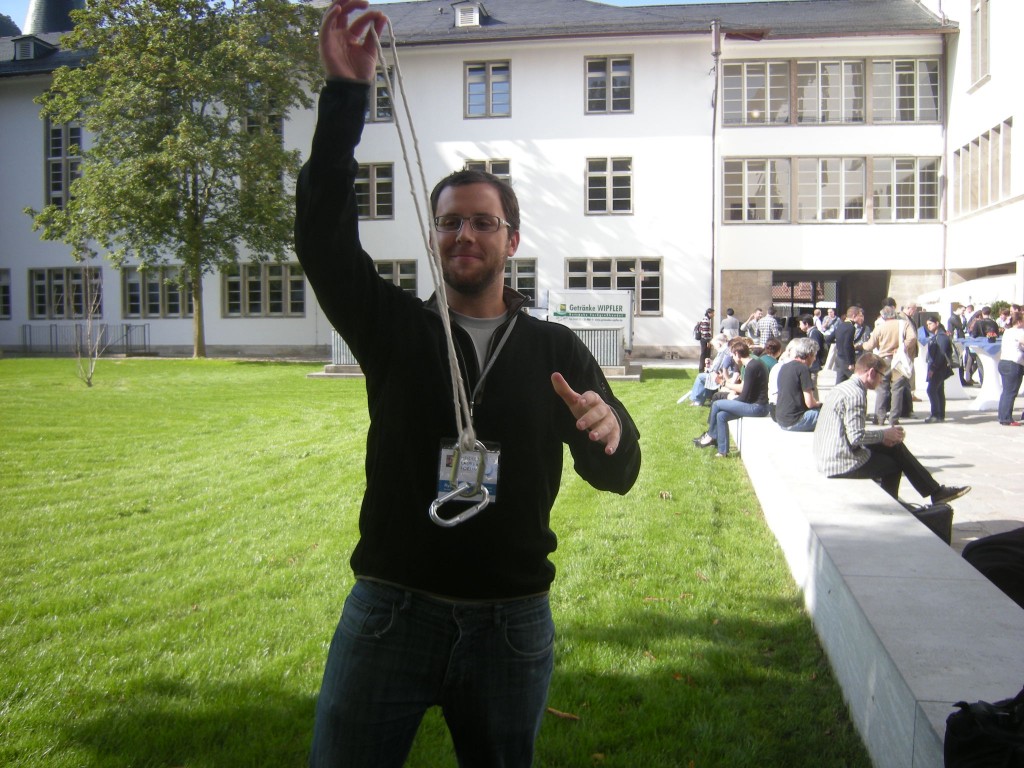Amazing Rope Trick
BLOG: Heidelberg Laureate Forum

Here’s an amazing trick that Curtis McMullen performed in yesterday’s workshop on Quantum Mechanics and Topology, organized by Ryan Grady. McMullen modestly declined to be photographed, so here Grady demonstrates the trick.
Step 1: Thread the rope through a carabiner and hold the ends, as shown.

Step 2: Clip a second carabiner through the two ends of the rope, taking care not to twist them. If properly done, the top carabiner should make a 90-degree angle with the bottom one.

Notice that, at this point, the carabiners and the rope are all linked together. You can’t pull them apart. If you were climbing a mountain you could safely hang from the lower carabiner and nothing bad would happen to you.
Step 3: Now clip the two carabiners together. (2 photos)

Getting ready to clip…

Clipped in!
Now your link should be twice as secure as before, right? Well, let’s see…
Step 4: Pull on the rope (2 photos)

Whoa! Where are those carabiners going?

The rope is no longer linked to the carabiners. Therefore, they have fallen completely off and dropped to the ground.
Warning: Do not try this when climbing a mountain! Or if you want, you can try it with somebody you really don’t like. For maximum effect, you should hang on to the rope while they clip in to the carabiners.
Mathematical Explanation: Think of the rope as a loop that threads through the “complement” of the two carabiners. In other words, it inhabits the part of the universe where the carabiners aren’t.
First thing to realize is that if the rope can be pulled free of the carabiners, that means it is topologically “trivial.” It can be shrunk down to a point without getting tangled up on the carabiners.
Topologists measure triviality using a gadget called the fundamental group. Basically, this group consists of “words” made of two letters, A and B. A means “go clockwise through the first carabiner” and B means “go clockwise through the second carabiner.” If you look carefully, in Step 2 the rope goes clockwise through carabiner 1 (A), then clockwise through carabiner 2 (B), then counterclockwise through carabiner 1 (A’), then counterclockwise through carabiner 2 (B’). So this loop corresponds to the “word” ABA’B’.
Also note that a rope that goes one time clockwise and one time counterclockwise around a carabiner will not be linked with that carabiner. This means that AA’ = 1 (the trivial loop) and BB’ = 1 (the trivial loop).
But here’s the cool thing! When the carabiners are unlinked, the order of the letters cannot be reversed. That is, AB is not the same as BA. So ABA’B’ is a non-trivial word. This is the mathematical way of saying that the rope cannot be pulled loose from the carabiners after Step 2.
However, when you link the two carabiners, it changes the whole topology of the “universe minus the carabiners.” (Isn’t that cool? When Ryan hooked them together, did he realize that the whole universe was changing around him?) Now the two letters A and B can be reversed, or AB = BA. But then ABA’B’ = BAA’B’ (by reversing A and B) = B1B’ (because AA’ = 1) = BB’ = 1 (because BB’ = 1). So ABA’B’ is now the trivial word.
Conclusion: The rope can be pulled free of the carabiners! In this way, by doing a purely mathematical calculation we could have predicted the result of the rope trick.
In mathematical parlance, the fundamental group of the “universe minus unlinked carabiners” is non-abelian, which means the order of multiplication matters. The fundamental group of the “universe minus linked carabiners” is abelian, which means the order of multiplication does not matter. The word “abelian,” by the way, comes from the name Niels Henrik Abel, after whom the Abel Prize is named. The Abel Prize is one of the four prestigious prizes whose laureates have been invited to the Heidelberg Laureate Forum, which is where I met Ryan Grady and Curtis McMullen this week. Spooky, isn’t it?
Anyway, I love this trick because it is the most concrete demonstration I have ever seen of the difference between an abelian and non-abelian group. If I were still a college teacher, I would use this example every time I taught a course in abstract algebra.
Thanks so much to Curtis McMullen for demonstrating this trick, and to Ryan Grady for performing the trick for the camera. By the way, McMullen says that he did not invent the trick; he got it from a book by Dale Rolfsen.


Amazing! O_o
Dana Mackenzie wrote (26 September 2013):
> Amazing Rope Trick […]
> Step 2: Clip a second carabiner through the two ends of the rope, taking care not to twist them. If properly done […]
> […] when you link the two carabiners, […] then ABA’B’ = BAA’B’ (by reversing A and B) = B1B’ (because AA’ = 1) = BB’ = 1
So – what if the second carabiner is not properly clipped as described, but instead, say, one end (loop) of the rope had been twisted once?
Upon linking the carabiners then perhaps
ABA’B = AA’BB = BB
(and the first carabiner drops off) ?
Wonderful, amazing!!!!!